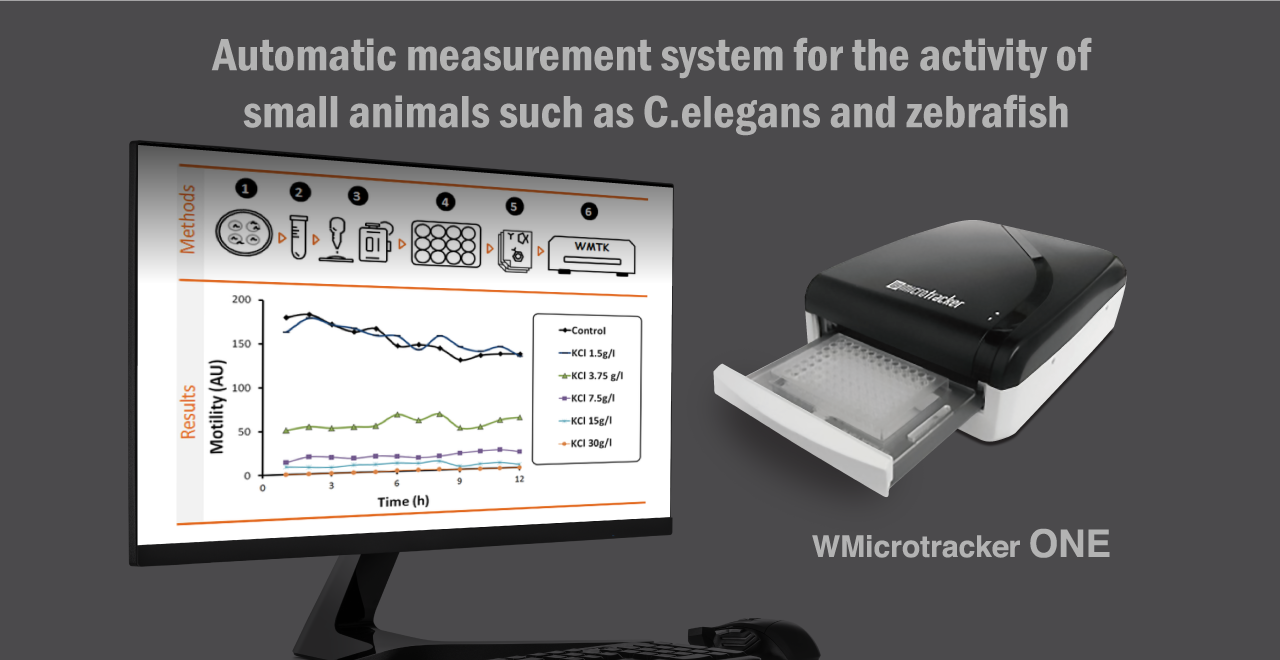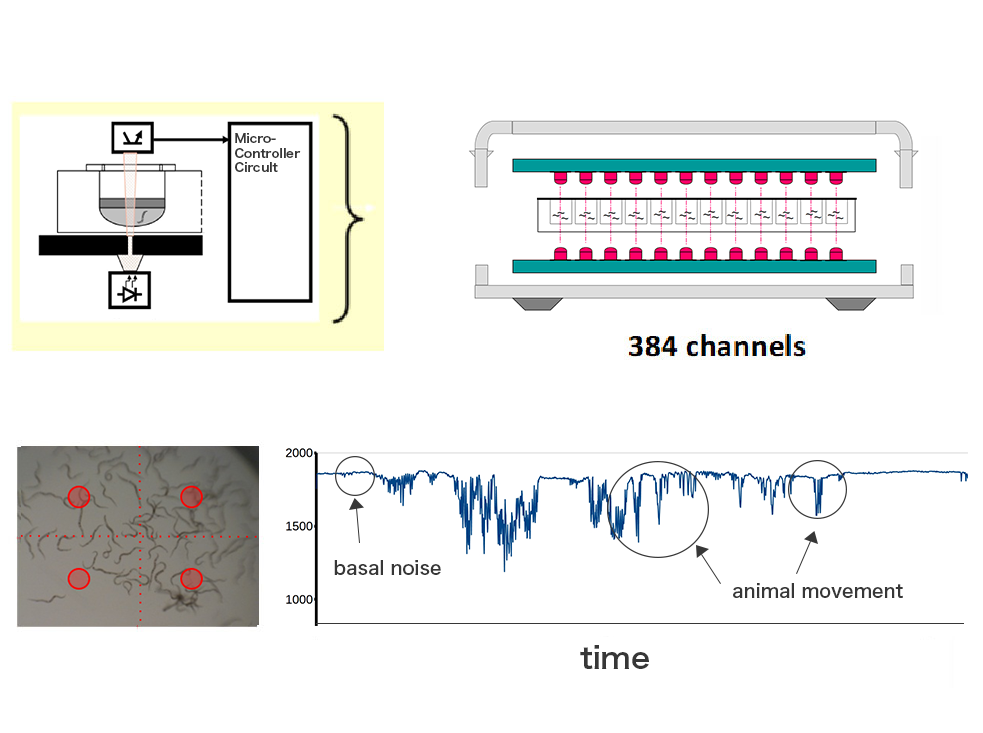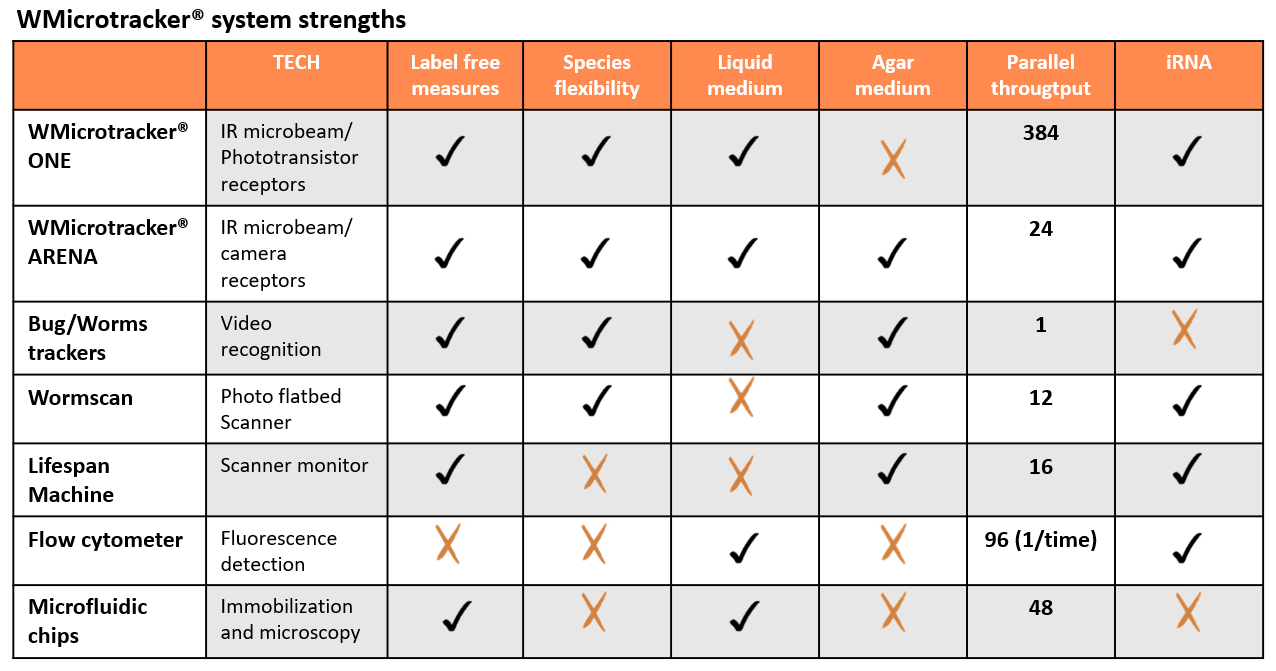

PRODUCT
Various applications
- Toxicology, Life span, Chemotaxis, Oxidative stress, Anthelmintic, Ecotoxicity, RNAi, etc.
Various organisms
- C. elegans, Parasites, Zebrafish and other small animals.
Easy to use
- Can be used in 6, 12, 24, 48, 96F, 96U, 384 well plates
Artifact suppression
- Non-invasive measurement of organism activity using IR detection method
FEATURES
It is able to measure behavior of any small animal cultured in microplates
- Measurement of animal activity in each well or group selected by the user
- Measurement time can be set up to 32000 minutes
- CSV file export and data analysis on original software
- Calcuration of average Activity, total activity, and standard error

The method is based on detecting the scattering of light caused by the movement of organisms when they are subjected to microbeams of infrared light.
The technology is implemented as a grid of infrared light microbeams: 2 microbeams per well of 96 wells, wavelength 880nm, 100 micrometers in diameter, power (1mW / mm2)
When any animal scatter the light from the microbeams, a locomotor activity counter is increased, and the result can be seen as the activity accumulated over time (total or kinetic activity).
This approach has been previously used to study circadian rhythms of fruit flies. Phylumtech's innovation rely in the sensitivity obtained by the microbeams, allowing the quantification of quasi-microscopic organisms.
This product is protected under international patents, owned by the Argentinian National Research Council CONICET (P20060105084AR, PCT/IB2007/054628, EPO &US patent granted) and licensed to PHYLUMTECH S.A. All rights reserve

APPLICATIONS
-
EFFECTS OF ALDICARB AND LEVAMISOLE IN C.ELEGANS
-
OXIDATIVE STRESS IN C.ELEGANS
-
BACTERIAL INFECTION IN C.ELEGANS
-
BACTERIAL INFECTION IN C.ELEGANS
-
TOXICITY IN ZEBRAFISH
-
DISEASE MODEL IN ZEBRAFISH: EPILEPSY
-
ECHINOCOCCUS GRANULOSUS MOTILITY MEASUREMENT
Publication
-
The nervous and prenervous roles of serotonin in Echinococcus spp
F Camicia , M Herz, L C Prada, L Kamenetzky, S H Simonetta, M A Cucher, J I Bianchi, C Fernández, K Brehm, M C Rosenzvit
(System: ONE, Model organism: Echinococcus spp)
-
An automated tracking system for Caenorhabditis elegans locomotor behavior and circadian studies application
ergio H Simonetta, Diego A Golombek
(System: ONE, Model organism: C. Elegans)
-
Neurodegeneration in C. elegans models of ALS requires TIR-1/Sarm1 immune pathway activation in neurons
Julie Vérièpe, Lucresse Fossouo, J Alex Parker
(System: ONE, Model organism: C. Elegans)
-
Reliable Screening of Dye Phototoxicity by Using a Caenorhabditis elegans Fast Bioassay.
Javier Ignacio Bianchi, Juan Carlos Stockert, Lucila Ines Buzzi, Alfonso Blázquez-Castro, Sergio Hernán Simonetta
(System: ONE ,Model organism: C. Elegans)
-
Optimization of a locomotion-based zebrafish seizure model
Philip Anthony Gilbert Shaw, Sujogya Kumar Panda, Alexandru Stanca, Walter Luyten
(System: ONE, Model organism: Zebrafish)
-
Nutraceutical emulsion containing valproic acid (NE-VPA): a drug delivery system for reversion of seizures in zebrafish larvae epilepsy model
Daniela Agustina Feas· Daniela Edith Igartúa· María Natalia Calienni·
Carolina Soledad Martinez· Marina Pifano· Nadia Silvia Chiaramoni·
Silvia del Valle Alonso · María Jimena Prieto(System: ONE, Model organism: Zebrafish)
-
Set-up of an infrared fast behavioral assay using zebrafish (Danio rerio) larvae, and its application in compound biotoxicity screening
Darío Bicharaa,b, Nora B. Calcaterrab, Silvia Arranzb, Pablo Armasb and
Sergio H. Simonettaa(System: ONE, Model organism: Zebrafish)
SPECIFICATIONS
| WMicrotracker One | |
| Microplate format compatibility | 6, 12, 24, 48, 96F, 96U, 384 well plates |
|---|---|
| Total IR channels | 384 |
| Organism Size | At least 500 um in size |
| Data processing | 2 minutes time block resolution |
| minimum measurement time (per plate) | 15-30min |
| Temperature control | No |
| Media | Liquid |
| Size | W230 x D297 x H95 mm |
| Product name (Code) | Microplate format compatibility | Total IR channels | Organism Size | Data processing | minimum measurement time (per plate) | Temperature controlTemperature control | Media | Size |
|---|---|---|---|---|---|---|---|---|
| WMicrotracker ONE | 6-24-96F-96U-384 well plates | 384 | At least 500 um in size | 2 minutes time block resolution | 15-30min | No | Liquid | W230 x D297 x H95 mm |